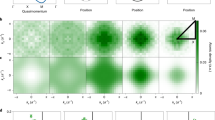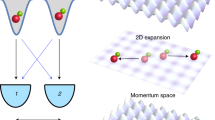Abstract
Ultracold atomic gases provide model systems in which to study many-body quantum physics. Recent experiments using Fermi gases have demonstrated a phase transition to a superfluid state with strong interparticle interactions1,2,3,4,5,6. This system provides a realization of the ‘BCS–BEC crossover’7 connecting the physics of Bardeen–Cooper–Schrieffer (BCS) superconductivity with that of Bose–Einstein condensates (BECs). Although many aspects of this system have been investigated, it has not yet been possible to measure the single-particle excitation spectrum (a fundamental property directly predicted by many-body theories). Here we use photoemission spectroscopy to directly probe the elementary excitations and energy dispersion in a strongly interacting Fermi gas of 40K atoms. In the experiments, a radio-frequency photon ejects an atom from the strongly interacting system by means of a spin-flip transition to a weakly interacting state. We measure the occupied density of single-particle states at the cusp of the BCS–BEC crossover and on the BEC side of the crossover, and compare these results to that for a nearly ideal Fermi gas. We show that, near the critical temperature, the single-particle spectral function is dramatically altered in a way that is consistent with a large pairing gap. Our results probe the many-body physics in a way that could be compared to data for the high-transition-temperature superconductors. As in photoemission spectroscopy for electronic materials, our measurement technique for ultracold atomic gases directly probes low-energy excitations and thus can reveal excitation gaps and/or pseudogaps. Furthermore, this technique can provide an analogue of angle-resolved photoemission spectroscopy for probing anisotropic systems, such as atoms in optical lattice potentials.
This is a preview of subscription content, access via your institution
Access options
Subscribe to this journal
Receive 51 print issues and online access
$199.00 per year
only $3.90 per issue
Buy this article
- Purchase on Springer Link
- Instant access to full article PDF
Prices may be subject to local taxes which are calculated during checkout





Similar content being viewed by others
References
Regal, C. A., Greiner, M. & Jin, D. S. Observation of resonance condensation of fermionic atom pairs. Phys. Rev. Lett. 92, 040403 (2004)
Chin, C. et al. Observation of the pairing gap in a strongly interacting Fermi gas. Science 305, 1128–1130 (2004)
Partridge, G. B., Strecker, K. E., Kamar, R. I., Jack, M. W. & Hulet, R. G. Molecular probe of pairing in the BEC-BCS crossover. Phys. Rev. Lett. 95, 020404 (2005)
Zwierlein, M. W., Abo-Shaeer, J. R., Schirotzek, A., Schunck, C. H. & Ketterle, W. Vortices and superfluidity in a strongly interacting Fermi gas. Nature 435, 1047–1051 (2005)
Luo, L., Clancy, B., Joseph, J., Kinast, J. & Thomas, J. E. Measurement of the entropy and critical temperature of a strongly interacting Fermi gas. Phys. Rev. Lett. 98, 080402 (2007)
Tarruell, L. et al. in Ultra-Cold Fermi Gases (Proc. Internat. School Phys. ‘Enrico Fermi’, Course 164) (eds Inguscio, M., Ketterle, W. & Salomon, C.) 845–855 (IOS Press, 2008)
Giorgini, S., Pitaevskii, L. P. & Stringari, S. Theory of ultracold Fermi gases. Rev. Mod. Phys. (in the press)
Damascelli, A. Probing the electronic structure of complex systems by ARPES. Phys. Scr. T109, 61–74 (2004)
Regal, C. A. & Jin, D. S. Measurement of positive and negative scattering lengths in a Fermi gas of atoms. Phys. Rev. Lett. 90, 230404 (2003)
Regal, C. A., Ticknor, C., Bohn, J. L. & Jin, D. S. Creation of ultracold molecules from a Fermi gas of atoms. Nature 424, 47–50 (2003)
Gupta, S. et al. Radiofrequency spectroscopy of ultracold fermions. Science 300, 1723–1726 (2003)
Schunck, C. H., Shin, Y., Schirotzek, A., Zwierlein, M. W. & Ketterle, W. Pairing without superfluidity: The ground state of an imbalanced Fermi mixture. Science 316, 867–870 (2007)
Schunck, C. H., Shin, Y., Schirotzek, A. & Ketterle, W. Determination of the fermion pair size in a resonantly interacting superfluid. Preprint at 〈http://arxiv.org/abs/0802.0341v1〉 (2008)
Dao, T.-L., Georges, A., Dalibard, J., Salomon, C. & Carusotto, I. Measuring the one-particle excitations of ultracold fermionic atoms by stimulated Raman spectroscopy. Phys. Rev. Lett. 98, 240402 (2007)
Chin, C. & Julienne, P. S. Radio-frequency transitions on weakly bound ultracold molecules. Phys. Rev. A 71, 012713 (2005)
Yu, Z. & Baym, G. Spin-correlation functions in ultracold paired atomic-fermion systems: Sum rules, self-consistent approximations, and mean fields. Phys. Rev. A 73, 063601 (2006)
Punk, M. & Zwerger, W. Theory of rf-spectroscopy of strongly interacting fermions. Phys. Rev. Lett. 99, 170404 (2007)
Perali, A. & Strinati, G. C. Competition between final-state and pairing gap effects in the radio-frequency spectra of ultracold Fermi atoms. Phys. Rev. Lett. 100, 010402 (2008)
Basu, S. & Mueller, E. J. Final-state effects in the radio frequency spectrum of strongly interacting fermions. Preprint at 〈http://arxiv.org/abs/0712.1007v2〉 (2007)
Veillette, M. et al. Radio frequency spectroscopy of a strongly imbalanced Feshbach-resonant Fermi gas. Preprint at 〈http://arxiv.org/abs/0803.2517〉 (2008)
He, Y., Chien, C.-C., Chen, Q. & Levin, K. Temperature and final state effects in radio frequency spectroscopy experiments on atomic Fermi gases. Preprint at 〈http://arxiv.org/abs/0804.1429v1〉 (2008)
Randeria, M. in Models and Phenomenology for Conventional and High-Temperature Superconductivity (Proc. Internat. School Phys. ‘Enrico Fermi’, Course 136) (eds Iadonisi, G., Schrieffer, J. R. & Chiofalo, M. L.) 53–57 (IOS Press, 1998)
Janko, B., Maly, J. & Levin, K. Pseudogap effects induced by resonant pair scattering. Phys. Rev. B 56, R11407–R11410 (1997)
Yanase, Y. & Yamada, K. Theory of pseudogap phenomena in high-T c cuprates based on the strong coupling superconductivity. J. Phys. Soc. Jpn 68, 2999–3015 (1999)
Perali, A., Pieri, A., Strinati, G. C. & Castellani, C. Pseudogap and spectral function from superconducting fluctuations to the bosonic limit. Phys. Rev. B 66, 024510 (2002)
Bruun, G. M. & Baym, G. Bragg spectroscopy of cold atomic Fermi gases. Phys. Rev. A 74, 033623 (2006)
Bulgac, A., Drut, J. E., Magierski, P. & Wlazlowski, G. Gap and pseudogap of a unitary Fermi gas by quantum Monte Carlo. Preprint at 〈http://arxiv.org/abs/0801.1504〉 (2008)
Barnea, N. Superfluid to insulator phase transition in a unitary Fermi gas. Preprint at 〈http://arxiv.org/abs/0803.2293〉 (2008)
Stewart, J. T., Gaebler, J. P., Regal, C. A. & Jin, D. S. Potential energy of a 40K Fermi gas in the BCS-BEC crossover. Phys. Rev. Lett. 97, 220406 (2006)
Gaebler, J. P., Stewart, J. T., Bohn, J. L. & Jin, D. S. p-wave Feshbach molecules. Phys. Rev. Lett. 98, 200403 (2007)
Acknowledgements
We acknowledge funding from the US NSF. We thank E. Cornell, D. Dessau and the JILA BEC group for discussions.
Author information
Authors and Affiliations
Corresponding author
Rights and permissions
About this article
Cite this article
Stewart, J., Gaebler, J. & Jin, D. Using photoemission spectroscopy to probe a strongly interacting Fermi gas. Nature 454, 744–747 (2008). https://doi.org/10.1038/nature07172
Received:
Accepted:
Issue Date:
DOI: https://doi.org/10.1038/nature07172
This article is cited by
-
Observation and quantification of the pseudogap in unitary Fermi gases
Nature (2024)
-
Effect of anisotropic spin-orbit coupling on condensation and superfluidity of a two-dimensional Fermi gases
Indian Journal of Physics (2024)
-
Quantum simulations with ultracold atoms in optical lattices: past, present and future
Journal of the Korean Physical Society (2023)
-
Spectroscopic probes of quantum gases
Nature Physics (2021)
-
Stochastic Schrödinger equation derivation of non-Markovian two-time correlation functions
Scientific Reports (2021)
Comments
By submitting a comment you agree to abide by our Terms and Community Guidelines. If you find something abusive or that does not comply with our terms or guidelines please flag it as inappropriate.



